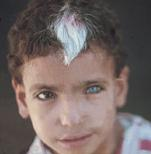Waardenburg Syndrome
Danielle Mercer1, Fern Tsien2, and Barbara Gordon-Wendt1
1 Department of Communication Disorders, LSUHSC School of Allied Health Professions
2 Department of Genetics, LSUHSC School of Medicine
Waardenburg syndrome affects about 1 in 40,000 people. It is passed down in an autosomal dominant fashion. Most cases of Waardenburg syndrome are inherited from a parent with Waardenburg syndrome, but there are a small number of cases arising from new mutations. There also may be a small number of cases that are autosomal recessive. Many people with Waardenburg syndrome have sensorineural hearing loss from birth, but some have normal hearing. The hearing loss may get progressively worse. The features of Waardenburg syndrome vary from one person to the next. There are several different types of Waardenburg syndrome, which adds to the variability.
The following are signs associated with Waardenburg syndrome:
- hearing loss
- white forelock (patch of white hair at forehead)
- pale blue eyes, different colored eyes, or two different colors in same eye
- wide-spaced eyes
For more information on Waardenburg syndrome, visit the following links:
http://ghr.nlm.nih.gov/condition/waardenburg-syndrome
http://www.nidcd.nih.gov/health/hearing/pages/waard.aspx
For information on patient support for Waardenburg syndrome, visit the following links:
http://www.dailystrength.org/c/Waardenburg-Syndrome-WS/support-group
http://www.rarediseases.org/rare-disease-information/rare-diseases/byID/430/viewAbstract

Child with Waardenburg syndrome
From http://www.i-am-pregnant.com/Birth/Birth-defects/Waardenburg-Syndrome
